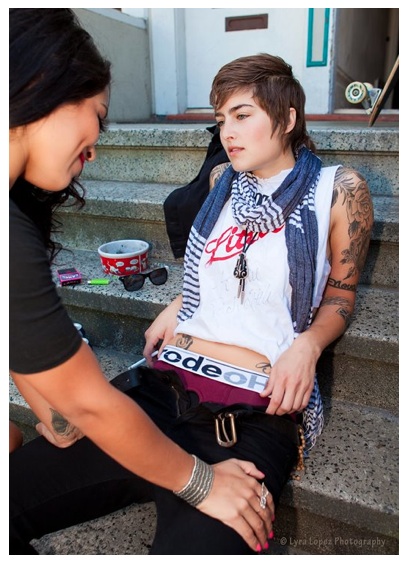Last week, the Center for Disease Control reported that teens and young adults have more oral sex than vaginal intercourse (as we mentioned in the NSFW Sunday). According to the report, this discrepancy is a result of a desire to maintain virginity, avoid pregnancy and avoid risk of contracting a sexually transmitted infection. But the CDC notes that because young people perceive oral sex as a risk-free behavior, they are “placing themselves at risk of STIs or HIV before they are ever at risk of pregnancy.”
But just what are the risks and how risky are they? While the CDC has yet to gather data on the actual frequency of STIs contracted through oral sex, Tracy Clark-Flory of Salon.com suggests we look at the way each STI is transmitted. Saliva does not carry HIV, but your mouth is a mucous membrane, and according to Gay Men’s Health, “cells in the mucous lining of the mouth may carry HIV into the lymph nodes or the bloodstream.” Clark-Flory writes that while HIV may be people’s biggest fear, it’s actually easier to transmit herpes, gonorrhea, chlamydia, syphilis and HPV. Less risky but still possible are Hepatitis A, gastrointestinal infections, and parasites.
While the CDC study includes race-based stats, the intersectionality of the report stops there: this is a report of on the prevalence of oral sex solely among opposite-sex partners. But the truth, of course, is that health risks associated with oral sex are extremely relevant to the interests of the queer community. It seems that in general, blow jobs are riskier than cunnilingus, but according to Professor Christopher Hurt of the Division of Infectious Diseases at the University of North Carolina at Chapel Hill, you are just as likely to contract syphilis, herpes, or HPV from a vagina as from a penis, “Since these infections can occur both inside the vagina and on the skin surface.” So queers, please take note: being on a vagina-only diet does not a risk-free lifestyle make.

Obviously, not everyone prefers only vagina or only penis, which is great! It’s also an important thing to keep in mind when you are deciding whether or not to use protection with a partner. What we can take from this study is that a queer person who encounters penises in their mouth is more likely in general to have contracted an STI than a queer person who doesn’t. So if you or your partner fits this description, you might consider taking an extra measure of protection. And if you have multiple partners, it’s even more important, because your risk increases with every additional person you add to your sexual network.
If you don’t use protection with your partner, you are what is known as “fluid-bonded.” This means that you have agreed to share your bodily fluids with each other. And with that agreement, much like the power to shoot webs from your hands, comes great responsibility. You should definitely get tested before doing so — if you don’t have health insurance, get on the internet and find your nearest free health clinic. If you’re in college, your health center should provide testing services. It’s possible to be fluid-bonded to one person while having multiple partners whom you are not fluid-bonded to, but you have an obligation to your fluid-bonded partner to use protection with everyone else. The key here is going to be communication. It’s not really fair to the people you are having sex with to have secrets that could put them at risk.

Ok, ok, I know what you’re thinking. We’re always talking about safe sex, but how many people actually practice it? Safe oral sex can be especially daunting for people with vaginas, as it requires a lot more thought than throwing on a condom. Using a dental dam or cutting up a condom for the same purpose requires that you hold it in place, and sometimes the last thing you want is something between your mouth and your partner’s vag. Maybe you worked really hard to get your mouth there after weeks of dramatic build up and now that it’s finally happening, you want to feel all the things, literally. But you guys, part of being a grownup is understanding consequences. The frontal lobe of your brain, which handles just that, won’t finish developing until you’re 25 (I have two more years of this shit to go, so I’m in the same boat). Those of us in our early 20s and under have to think extra hard about the consequences of our actions, since these realizations probably don’t yet come naturally.
But! Safe oral sex doesn’t have to be a total drag. It can be really fun! Having to take some extra steps in planning out your sexual routine and communicating about it can make for really great sex. Don’t get me wrong, spontaneity is great too — but the more you communicate about sex, the greater chance you have for trying new things and expanding your repertoire.

If you are using a dental dam or a modified condom, it helps a lot to use lube on both sides. And flavored, edible lube is totally a thing. If you are worried that sensation will be sacrificed through the protection, grab a vibrator and use it along with your tongue. Just make sure you don’t use silicone-based lube with a silicone toy (and always make sure that neither party is allergic to latex before using latex-based barrier methods or condoms).
Hot tip: non-microwavable saran wrap can be used, as well. And if you are looking for a hands-free experience, why not try making some saran wrap underwear? You can make it right from the roll onto her body. Again, use lube on both sides, and keep some safety scissors nearby in case she wants to take it off in a hurry.
Tell me your favorite ways to have safe and sexy oral sex!








Comments
THANK YOU. The rates of HPV-induced throat cancer are going WAY up–and unfortunately there’s no throat swab like a pap smear to see if there’s HPV in your throat.
I saw an estimate that the rates of HPV-induced throat cancer in men (assuming here straight men) may bypass the rates of cervical cancer in the next ten years.
Just…get your tests, get your HPV vaccine (don’t assume it’s enough) and seriously think about whether barrier-free sex or no cancer/STIs is more important to you.
I’ve done stupid things–this is hopefully a wakeup call for me not to do them anymore.
at least the men-having-hpv-in-the-throat thing means more ladies are getting some oral sex? so maybe that means it’s losing its stigma/terrible double standard? teeny bright side?
but using protection with all that oral sex would be better. by about a million percent.
HPV induced throat cancer— Wow,one more thing for me to be paranoid about.Thanks for that info !
Actually, there is an easy way for your dentist to test for oral HPV:
http://www.oraldna.com/oral-hpv-testing.html
And here’s a (mostly unhelpful) article about oral HPV testing by the NYTimes: http://www.nytimes.com/2009/02/03/health/03cancer.html?_r=0
If you have HPV, you should see your gynecologist every 6 months, instead of yearly. If you know you have a partner with HPV, or think you might have contracted it orally, maybe it’s good to have one of these tests done yearly by the dentist.
xo
So…. this is something I was very paranoid about. Many times when I saw the doctor and brought this up they would shrug and say that *lesbians had the lowest STD rates and that I didnt have much to be worried about…which was crazy to me!!!
Anyhow, when I was single I had casual partners, some of which were bisexual and had been sleeping with men before I came around. I would make it a point for both of us to get tested, which as we all know can be nerve wracking but it’s still important. Also, it was hella awkward at times, like asking them if they had been tested but… i had to otherwise id be worried the day after if i didnt ask.
Just be smart and awkward as it is, ASK and get TESTED! Also, after we both had shared our results and we were ready to have sex, doing it was MUCH better because you didnt have your conscious nagging you!
Printing this out to take to my gyno. If I ask to get tested for STD’s I have my reasons damn it! I don’t need him to argue that because I’m obsessive about safe sex and I fuck girls not guys I don’t need to be tested… Some risk factors should be grounds for immediate, no questions asked testing like I dunno… I may have gone down on chicks who test positive, I have a weak immune system, I’ve had a few drunken threesomes, I tend to be impulsive drunk or sober (guilty of all charges with no regrets). Rant over, thanks for indulging me!
Shouldn’t you always be able to get tested without providing reasons to your doc? Like isn’t “I want to get tested” enough of a reason?
It really should be enough, but I have personally had to fight for it – one nurse practitioner told me I didn’t need to get tested because their clinic’s funding had been cut. Some places you really have to advocate for yourself.
Sadly, it was an issue. I ended up going elsewhere to get tested.
So I started seeing this girl and she was very up front and told me she had HPV.
Now I am a little freaked, especially by the first comment. I am always tested and clean and use
protection. I also haven’t have a lot of partners. She is great, I am just really really really scared of infection.
I had lymphoma before I was thirty. I don’t want more medical crap to deal with. This article makes it sound almost inevitable.
Aww, just call me relationship ruiner. :P
But seriously it’s amazing that she was super upfront with you and now you know to continue to use protection and you should be good. I don’t think it should be a dealbreaker.
If you’ve had sex with a few people, you’ve probably had sex with someone with hpv already, since more than half of people have had it at some point (and frequently don’t know it). Not saying you shouldn’t be careful with her–you should be careful with everyone! But also, sex has risks.
I just had to share: My girlfriend after reading this article goes, “Welp, I guess we’re fluid-bonded. It’s ok, I don’t have any weird warts or anything.” (She’s a little drunkers)
Great article, Gabrielle! Saran wrap underwear is taking me back to Smith Convocation. Good times.
Haha that was my exact thought about my girlfriend. And I’m sober. Oops?
*blushes*
Welp. Now I’m sober.
“Saran wrap underwear is taking me back to Smith Convocation”
yup, I picked the right college. Six days to NORTHAMPTON and SMITH.
I take issue with the following comment, “According to the report, this discrepancy is a result of a desire to maintain virginity….”
Yet again, “vaginal intercourse” is considered “sex” and losing ones virginity, while “oral sex” is reduced to what exactly… ?? *face palms*
Yeah I hear you. But our fucked up sex ed system, or lack thereof, has led to this hyper-emphasis on “no penis in vagina sex until marriage!” dogma that 1) tacitly says queers can NEVER have sex, unless they live in the few states that have legalized gay marriage, and 2) only penis-in-vagina sex is sex.
Which is not only bullshit, but dangerous as hell, for reasons just such as the one illustrated by the fact that more people are having risky oral sex.
Honestly, ANY sexual act is sex, far as I’m concerned, and “virginity” is a waaaay outdated concept with its roots in a highly misogynistic and heteronormative world view. Boo to it! Boo, I say!
My mum told me that lesbians were girls who had baths together.
So I was having sex for years before I figured out what it was, and that I was probably pretty gay.
That’s how ingrained the whole idea of ‘penis in vagina is the only real sex’ was in my head.
Which is kind of a shame, coz I would have liked to have waited, in retrospect.
I’m sorry to laugh at your confusion, but I’m actually laughing my ass off over here at “girls who had baths together.”
I am only gay if showers count as baths, in that case.
Oh feel free to laugh. I do.
I just wonder if that’s what my mum actually thought, and if she knows better now. Unfortunately we’re in the not talking stage of my coming out so I probably can’t ask!
I’m with you on this!! And I wanted to talk about how problematic it is to define virginity as a penis going into a vagina, or even to have a singular definition of virginity in general, but then I realized that it could potentially take the rest of my life rather than an afternoon. So I decided to hone in on the parts pertinent to eating pussy.
I totes need an Autostraddle article about this. I have this discussion re: problematic definition of virginity approximately 5 times a year and could do with an AS article to shove in peoples faces & back me up rather than hours of face-palming that tends to occur instead.
I love how people keep writing “penis in vagina” HAHAHAHAH
Thank you for this! From dental surgery to sexual pleasure… dental dams must lead really interesting lives! Sounds like a solid topic for a book or documentary.
“Dam it!: A social-sexual history of dental dams.” Definitely my new post-doc topic.
Lesbians are indeed at risk for STIs. I did some research on the topic in a public health class last year. I basically found that women who have sex with women are at risk for STIs and doctors are unaware of said risk. Doctors automatically assume heterosexuality and if corrected assume that lesbians are not at risk. This is simply not true. Unfortunately I am too lazy to dig up said research but I found an article that looks similar: http://wwwnc.cdc.gov/eid/article/10/11/04-0467_article.htm
I only read the abstract so hope the rest holds true.
Seriously just stared at the back of my throat in the mirror for 5 minutes. Thanks! Ha.
We should come up with a catchy safe sex jingle like “no glove, no love” (which definitely does apply, but still). Maybe “No saran wrap? Keep your snatch trapped.” Too wordy, tho.
“No dam, no bam!”
You are officially my hero.
This wins
how about “No Dam? No Ma’am!”
I feel like safe sex would be easier if 1.) we were educated about it 2.) condom companies also made dental dams. I mean, I don’t think I’ve ever just seen dental dams in the store next to the condoms. They’re kind of hard to get. Also, maybe they ought to put more work/research into making them more comfortable/pleasurable to use.
Heeeyyyy, what if they came up with ones that have the funky patterns on them like some of the big name condom brands? That’d be interesting…!
Good advice! As an aside, don’t say what this girl I was seeing did:
“So, because you’re bi, I’m gonna need you to get tested before we have sex.”
And the sound after than was the sound of my vagina slamming it’s doors in her face FOREVER.
Oh my god whaaaaat. Awful.
Also is anybody else now imagining a vagina snapping shut?
Thanks a lot Marika, now I have visuals of a vagina aka “Venus fly trap,” snapping someone’s face off, then going all praying mantis on them, while shouting, “NO DAM, NO BAM!!! GTFO!”
This actually reminds me of a comic a friend and I did, in which the characters revolved around the female reproductive system… uh, yep, I am consumed by lol’s atm and now I have the urge to actually draw this out on paintbrush.
But man, what a way to die…
To be fair, it’s even noted in the original article:
“What we can take from this study is that a queer person who encounters penises in their mouth is more likely in general to have contracted an STI than a queer person who doesn’t. So if you or your partner fits this description, you might consider taking an extra measure of protection.”
So, I don’t take that request to be an unreasonable precaution. I would ask for the same.
This is all very important information– and also makes me upset that no one knew/told us this, back when my first girlfriend blithely told me that lesbians couldn’t give each other STDs (I didn’t hear of dental dams until the condom co-op had a table at orientation my freshman year of college)– but also. That first picture with the RodeoH and the steps? HOLY FUCK.
Oh man, those bedroom eyes, I could look at them alllll day. Might take that picture and put it as my background (wait no I use my laptop at work).
maybe one of you gays will be able to shed light: can you catch thrush in the throat from oral sex if she has it?
Yes! Here, read this: http://develop.autostraddle.com/hot-town-summer-in-the-city-keep-your-vag-from-feeling-dirty-and-gritty-141607/
Needless to say great post. Sex ed needs to extend its range of focus, so it’s easier to talk about STI in any form…
A few things here…
Educate yourself about the HPV vaccine. There are reports of adverse effects that aren’t reported on (as with any vaccine). If half the population is already going to contact it, then it might not do you any good. Just saying. http://articles.mercola.com/sites/articles/archive/2008/11/15/how-u-s-government-is-covering-up-hpv-vaccine-side-effects.aspx
@MSE Is there any way you can find a female gyno in your area? I find the experience much easier to handle.
Great tips about Saran Wrap and knowing if you or your partner have a latex allergy! Wal-green’s sells both latex and non gloves in their medical isle, at least in my area they do. Don’t be like Evan and use the dishwashing glove!
“a queer person who encounters penises in their mouth”
who ENCOUNTERS penises in their mouth?? like, “oh hello! i wasn’t expecting to see you in here”
Definitely agree that safer sex is not visible enough for lesbians. When I started seeing my first sorta-proper girlfriend (long story), I went to a local pharmacy/sexual health clinic for advice on safer sex. All through school, we were told “use condoms, be safe!” so I figured, it’d be best to find out what the risks are, and where better to go than a clinic? No joke, I had to speak to about 3 different people before this one woman outright told me that there was nothing at all to worry about, because as long as we didn’t share toys, there was no chance of catching anything. According to her, getting checked out would be a waste of my time.
I blame, to an extent, sex ed in schools. Actually, whilst I’m ranting, all you British out there, consider signing this epetition for more rounded sex ed? It’s lumped a lot of things together, but still.. Worth it if you ask me (as far as I’m aware, you have to be resident in Britain to sign it, but all the rest of you, feel free to try!) http://epetitions.direct.gov.uk/petitions/35070
Thanks for using my picture for this. but can you not.